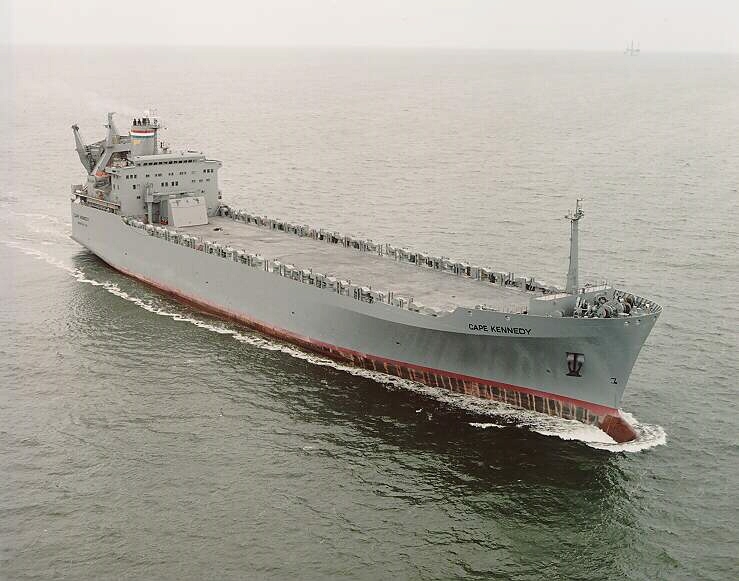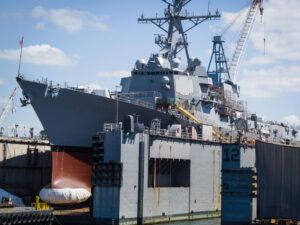The U.S. Ready Reserve Fleet (RRF) of cargo and fuel ships that move military gear around the world when needed for a conflict is in serious need of an upgrade. The fleet is aging and generally not ready for war.
Its job description doesn’t match its current condition. A component of the U.S. Maritime Administration (MARAD), the RRF is supposed to provide “transport of Army and Marine Corps unit equipment, combat support equipment and initial resupply during critical surge periods — the period of time before commercial ships can be secured for similar support.”’
As the first line of action for ships tapped to move military cargo in wartime conditions, the readiness of these ships to move is of vital national security importance. The challenge with this fleet of reserve fuel and cargo carriers is that they are all very old, and many need immediate replacement with younger, more flexible vessels.
The average age of the RRF is 44 years old, an age when most comparable vessels have been retired for at least a decade. The U.S. Transportation Command and its Maritime Component Military Sealift Command want to buy newer ships, but they are limited to purchasing just nine used ships per year. This limit was imposed in 2006 by Congress in order to encourage the construction of new ready reserve ships in U.S. shipyards.
This is a laudable goal, but the rapidly aging RRF is in desperate need of newer, more functional ships. In its last activation exercise (September 2019) to test the ability of the RRF at short notice, only 60% of the RRF ships were deemed “ready” and only 40% could get underway on time. Many could not due to mechanical failures and lack of trained personnel to crew RRF ships threatens future activation efforts.
The current National Defense Authorization Act contains a provision to lift the nine-ship limit on used ship purchases. It is vital that Congress approves this waiver in order to get functional ships to the RRF.
Remove cap on used ship purchases
Air Force Gen. Jacqueline Van Ovost, chief of the U.S. Transportation Command, has stressed the urgency to remove the cap. Recapitalizing the RRF, she told a House panel, means removing the overall limit on the number of used sealift vessels DOD can procure, currently authorized at nine ships. We are already a generation late in recapitalizing a ready sealift fleet to meet our national objectives.”
A 2011 National Defense Sealift Fund regulation originally limiting such purchases to seven ships was amended to nine ships in 2021. This limit could be amended to include a larger purchase of used, foreign ships.
While there are challenges in increasing the number of used vessels, especially in the commonality of spare parts and fleet sustainment, lowering the average age of the Ready Reserve Fleet to improve its short-term readiness for combat use is of vital importance given the current international situation with two peer adversaries. U.S. industry will need time to build replacements in numbers and short-term purchase of used foreign vessels is the best choice to improve readiness of the RRF in the next five years.
There is also a danger that given China’s dominance of the maritime shipping market in terms of ship and port ownership that a Sino-American war could significantly reduce the overall number of ships available for the U.S. to requisition at short notice. Procuring more used foreign ships now could help alleviate potential shortages in the event of conflict.
RRF needed for maritime sustainment
The goal in raising the number of used ship purchases is no longer just about moving lots of tanks and troops for expeditionary operations. Sustaining the U.S. Navy and U.S. Marine Corps global operations in a contested environment will require many more combat logistics force ships than are currently available. Increasing the RRF can help decrease the shortfall in logistics ships for sustainment of forces at the outset of conflict.
The Navy’s Distributed Maritime Operations (DMO) concept needs a distributive logistics operations concept in support that can only be achieved by acquiring more ships to service a more widely dispersed fleet. The Tanker Security Program (TSP) and Maritime Security Program (MSP) are steps in the right direction, but still likely not enough ships to support global U.S. Navy and Marine Corps operations without help from RRF ships.
The get-well plan
Congress should amend the National Defense Sealift Fund to allow MARAD to purchase more used ships in order to decrease the average age of the force and improve readiness. Limits could be reimposed when U.S. shipbuilding is ready to provide cost-effective replacements.
These ships should undergo upgrades and repairs in U.S. shipyards when acquired. Promoting such upgrades and repairs could necessitate expanded shipyard capacity. In line with this, Congress should consider a National Defense Shipyard Fund to purchase and acquire heavy equipment such as floating drydocks, heavy lift vessels and cranes to better service both these RFF ships, as well as Navy and Military Sealift Command vessels. These assets could then be lent or leased to repair yards, further enhancing U.S. maritime infrastructure and allowing those yards to expand to meet demand.
The focus of effort in used ship purchases should also be fleet sustainment as the current combat logistics force lacks sufficient numbers of ships to support DMO. The goal is to make both the Ready Reserve Fleet and U.S. shipyards more effective.
The old aphorism (from Gen. Omar Bradley to U.S. Marine Corps Commandant Robert Barrow,) that amateurs study tactics while professionals study logistics underscores that wars are won just as much by the less glamorous elements – the RRF and sustainment ships — as the state-of-the-art weapons systems and frontline forces. The shortfall must be addressed now.







